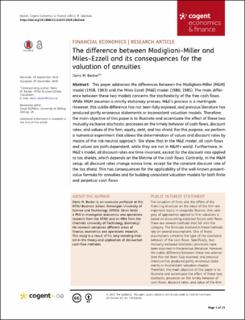| dc.description.abstract | This paper addresses the differences between the Modigliani-Miller [M&M] model (1958, 1963) and the Miles-Ezzell [M&E] model (1980, 1985). The main difference between these two models concerns the stochasticity of the free cash flows. While M&M assumes a strictly stationary process, M&E’s process is a martingale. However, this subtle difference has not been fully exposed, and previous literature has produced partly erroneous statements or inconsistent valuation models. Therefore, the main objective of this paper is to illustrate and accentuate the effect of these two mutually exclusive stochastic processes on the timely behavior of cash flows, discount rates, and values of the firm, equity, debt, and tax shield. For this purpose, we perform a numerical experiment that allows the determination of values and discount rates by means of the risk-neutral approach. We show that in the M&E model, all cash flows and values are path-dependent, while they are not in M&M’s world. Furthermore, in M&E’s model, all discount rates are time-invariant, except for the discount rate applied to tax shields, which depends on the lifetime of the cash flows. Contrarily, in the M&M setup, all discount rates change across time, except for the constant discount rate of the tax shield. This has consequences for the applicability of the well-known present-value formula for annuities and for building consistent valuation models for both finite and perpetual cash flows. | en_US |

